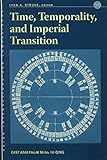Time, Temporality, and Imperial Transition : East Asia from Ming to Qing / ed. by Lynn A. Struve.
Material type: TextSeries: Asian Interactions and Comparisons ; 8Publisher: Honolulu : University of Hawaii Press, [2005]Copyright date: ©2005Description: 1 online resource (312 p.)Content type:
TextSeries: Asian Interactions and Comparisons ; 8Publisher: Honolulu : University of Hawaii Press, [2005]Copyright date: ©2005Description: 1 online resource (312 p.)Content type: - 9780824828271
- 9780824873905
- online - DeGruyter
- Issued also in print.
| Item type | Current library | Call number | URL | Status | Notes | Barcode | |
|---|---|---|---|---|---|---|---|
 eBook
eBook
|
Biblioteca "Angelicum" Pont. Univ. S.Tommaso d'Aquino Nuvola online | online - DeGruyter (Browse shelf(Opens below)) | Online access | Not for loan (Accesso limitato) | Accesso per gli utenti autorizzati / Access for authorized users | (dgr)9780824873905 |
Frontmatter -- Contents -- Series Editor's Preface -- Acknowledgments -- Maps -- Introduction -- Part I. Manchu and Han Historical Conciousness in Flux -- 1. Whose Empire Shall It Be? -- 2. Toward Another Tang or Zhou? -- Part II. Temporalities of National Subjugation and Resistance -- 3. Contesting Chinese Time, Nationalizing Temporal Space -- 4. Mongol Time Enters a Qing World -- Part III. Alterities in Folk Culture and the Symbolics of Calendar Time -- 5. The "Teachings of the Lord of Heaven" in Fujian -- 6. "Birthday of the Sun" -- Han-Script Glossary -- List of Contributors -- Index
restricted access online access with authorization star
http://purl.org/coar/access_right/c_16ec
Time is basic to human consciousness and action, yet paradoxically historians rarely ask how it is understood, manipulated, recorded, or lived. Cataclysmic events in particular disrupt and realign the dynamics of temporality among people. For historians, the temporal effects of such events on large polities such as empires-the power projections of which always involve the dictation of time-are especially significant. This important and intriguing volume is an investigation of precisely such temporal effects, focusing on the northern and eastern regions of the Asian subcontinent in the seventeenth century, when the polity at the core of East Asian civilization, Ming dynasty China, collapsed and was replaced by the Manchu-ruled Qing dynasty.Contributors: Mark C. Elliott, Roger Des Forges, JaHyun Kim Haboush, Johan Elverskog, Eugenio Menegon, Zhao Shiyu.
Issued also in print.
Mode of access: Internet via World Wide Web.
In English.
Description based on online resource; title from PDF title page (publisher's Web site, viewed 02. Mrz 2022)


